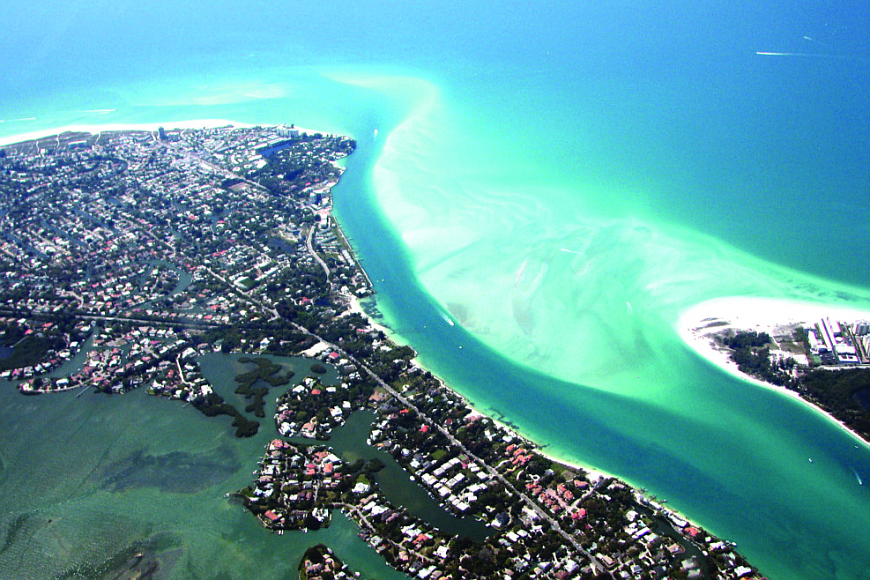- November 24, 2024
-
-
Loading

Loading

Less than a month after environmental protection groups came together for Party on the Pass, opponents of plans to dredge Big Pass may have a reason to celebrate.
Sarasota County has received the draft of a third-party review it commissioned on the U.S. Army Corps of Engineers’ proposed Lido Key renourishment project. The Army Corps plans to mine sand from Big Pass and place groins on the shoreline near the south end of the Key. The county commissioned the review to analyze how this might affect shorelines at Ted Sperling Park and on Siesta Key, as well as navigation in the inlet.
The draft review, completed by engineering consulting firm Atkins, suggests the planned project, particularly with taking sand from Big Pass, may contribute to erosion near Ted Sperling Park. It also calls for more conclusive information about the use of groins on Lido.
But perhaps the report’s most significant finding, in the eyes of the project’s opponents, is there’s not enough information to know how it will affect downdrift shorelines because of missing documentation and an ineffective model.
“It reaffirms every concern that we have had,” said Peter van Roekens, chairman of local advocacy group Save Our Siesta Sand 2.
“There appears to be conflicting information about proposed project elements (i.e. number, location and geometry of groins; dredge volumes, boundaries, depths and frequency, etc.) between the supplied reports, information provided in public meetings and that contained in the Joint Coastal Permit (JCP) application to the Florida Department of Environmental Protection (FDEP),” the draft report states.
In its draft review, Atkins said it requested additional information from the Corps, but had not received it.
Regarding the use of the ebb shoal near Big Pass as a source of fill sand, the report indicated that the Corps is moving in the wrong direction — literally.
The natural movement of sand is southward, across Big Pass and onto Siesta, maintaining stable beach conditions there.
Most inlet ebb-shoal mining projects move sand in the opposite direction of what’s proposed. They place fill on downdrift beaches, “maintaining and augmenting the natural flow of sand,” according to the report.
“Back-passing” sand by dredging the shoal may have adverse consequences on Siesta, especially in light of the amount that would be dredged relative to the estimated annual natural movement of sand.
Among the issues noted in the draft is a lack of studies analyzing long-term effects of the proposed activities, which include an initial ebb-shoal dredging with groin construction and beach renourishment. Other missing or incomplete elements, according to the report, include documentation of how sand moves in the area.
Atkins also questioned the model used to determine the effects of placing groins on the shoreline, claiming it does not adequately predict the effects of nearshore currents and resulting sand movement. It also raised questions and wanted explanations about how the Corps used its model, including certain parameters it set.
Atkins recommended an alternate mode.
If simpler alternatives to protecting individual properties have been studied, and further modeling of the proposed project’s effect shows no detriment to the natural movement of sand, “...the sponsor should consider building groins and using an offshore sand source or a smaller amount of sand from the Big Pass ebb shoal complex for nourishment.”
According to spokesman Jason Bartolone, the county has 10 days to review the draft report and submit comments or questions to Atkins, which then has seven days to revise and finalize the report.
The purpose of the third-party peer review is to help provide a better understanding of the project, given the concerns of the community, Bartolone said.
The Corps had submitted its response to the FDEP’s request for additional information last month, predicting no adverse effects to the coastal system if it were to leave elements of its plan in place.
Laird Wreford, county coastal resources manager, and City Engineer Alex DavisShaw were unavailable for comment, according to city and county staff. The Army Corps did not immediately return calls for comment as of press time.
Justin Bloom, of advocacy group Suncoast Water Keepers, said he hopes Sarasota County will raise the concerns outlined in the draft to the FDEP, which is considering the Corps’ application for the project. He also hopes the county will support several groups’ call for a full environmental impact study.
“No matter what,” Bloom said, “they should do a comprehensive study.”